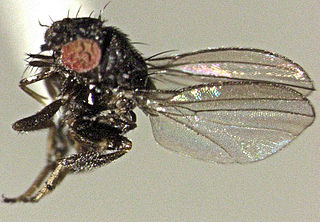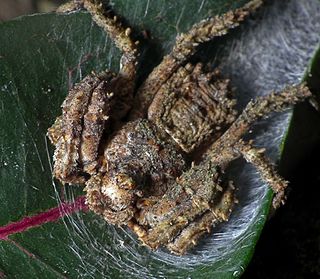
The Thomisidae are a family of spiders, including about 170 genera and over 2,100 species. The common name crab spider is often linked to species in this family, but is also applied loosely to many other families of spiders. Many members of this family are also known as flower spiders or flower crab spiders.

Lynx spider (Oxyopidae) is a family of araneomorph spiders first described by Tamerlan Thorell in 1870. Most species make little use of webs, instead spending their lives as hunting spiders on plants. Many species frequent flowers in particular, ambushing pollinators, much as crab spiders do. They tend to tolerate members of their own species more than most spiders do, and at least one species has been identified as exhibiting social behaviour.

Misumena vatia is a species of crab spider with a holarctic distribution. In North America, it is called the goldenrod crab spider or flower (crab) spider, as it is commonly found hunting in goldenrod sprays and milkweed plants. They are called crab spiders because of their unique ability to walk sideways as well as forwards and backwards. Both males and females of this species progress through several molts before reaching their adult sizes, though females must molt more to reach their larger size. Females can grow up to 10 mm (0.39 in) while males are quite small, reaching 5 mm (0.20 in) at most. Misumena vatia are usually yellow or white or a pattern of these two colors. They may also present with pale green or pink instead of yellow, again, in a pattern with white. They have the ability to change between these colors based on their surroundings through the molting process. They have a complex visual system, with eight eyes, that they rely on for prey capture and for their color-changing abilities. Sometimes, if Misumena vatia consumes colored prey, the spider itself will take on that color.

Milichiidae are a family of flies. Most species are very small and dark. Details of their biology have not yet been properly studied, but they are best known as kleptoparasites of predatory invertebrates, and accordingly are commonly known as freeloader flies or jackal flies. However, because of the conditions under which many species breed out, they also are known as filth flies.

Sidymella rubrosignata is a species of crab spiders found in Australia. It is a common spider, often seen on Dianella plants.

Thomisus onustus is a crab spider belonging to the genus Thomisus. These spiders are found across Europe, North Africa, and parts of the Middle East and Asia. T. onustus reside in flowers in lowland vegetation. Females are distinguished by their larger size and ability to change color between white, yellow, and pink as a means of matching flower color. This cryptic mimicry allows them to both evade predators and enhance insect prey capture abilities. Males are smaller, more slender, and drab in coloration, usually green or brown. T. onustus is also distinguished from other relatives by its distinct life cycle patterns in which spiderlings emerge in either late summer or early spring. Furthermore, T. onustus have developed a mutualistic relationship with host plants where spiders feed on and/or deter harmful florivores while benefiting from the plant's supply of pollen and nectar, which T. onustus spiders are able to use as food sources, especially during periods of low insect prey abundance.
Corynethrix is a monotypic genus of South Pacific crab spiders containing the single species, Corynethrix obscura. It was first described by Ludwig Carl Christian Koch in 1876 based on a female specimen. They have been found in New South Wales and Queensland. A male has not yet been identified, and there is very little known about the biology and behaviour of this species and its relatives.

Stephanopis is a genus of crab spiders first described by Octavius Pickard-Cambridge in 1869. It was erected for five then newly described species, including S. altifrons, from Australia. Stephanopis was characterized by the high cephalic region with unequally sized anterior eyes disposed in a strongly recurved row, opisthosoma ending in several spiniform projections and dorsoventrally depressed habitus. According to Pickard-Cambridge, the single specimen used for the description of S. altifrons was dry-pinned. Therefore the specimen could not be properly examined, so it was not possible to determine if the specimen was adult. Moreover, he states his own sketch of the spider as “hasty”. This may explain why the somatic characters were inadequately described, genitalic features were not mentioned at all, and the illustrations were not detailed enough, making the species unidentifiable.

Bomis is a genus of very small crab spiders, first described by German arachnologist Ludwig Carl Christian Koch in 1874. Five species are currently described, with three species from India and two from Australia.

Thomisus spectabilis, also known as the white crab spider or Australian crab spider, is a small spider found in Australia and far east Asia.

Maratus scutulatus is a species of Australian spider in the family Salticidae.

Cyrtophora hirta is a species of tent spider found in the Australia. The southern range of distribution is near Sydney, though there are New Guinea and Tasmanian records on the Atlas of Living Australia. Ludwig Koch described the species in 1872 from specimens from Bowen, Queensland.

Euryopis splendens is a species of comb-footed spider in the family Theridiidae. The range of distribution is the south east of Australia. The spider lives under stones or bark.

Australomisidia cruentata, one of the crab spiders, is a small spider found in Australia. The body length of the female is up to 5 mm, the male 3 mm. An ambush predator, often seen on flowers in the Pultenaea group of egg and bacon plants, belonging to the pea family. The egg sac is also laid on the flowers. Petals being fastened with silk in a chamber. The spider stays with the eggs, probably still hunting from the entrance of the retreat, with the egg sac nearby. Prey is small flying insects. The genus Australomisidia was created in 2014, the word being a combination of Australia and Thomisidae, the crab spiders.

Venatrix furcillata, one of the wolf spiders, is a mid sized spider found in eastern Australia. The body length of the female is up to 13 mm, the male 9 mm. The abdomen has distinctive tapering markings. Sometimes noted in suburban gardens and lawns. It lives in a simple burrow, but may be seen migrating in large numbers to a communal web, an unusual feature for wolf spiders. The grey coloured spherical egg sac is around 6 mm in diameter, carried by the female. Eggs are 45 to 60 in number, 0.8 mm in diameter. Prey is ground dwelling insects. The spider has been identified as occurring in Queensland, New South Wales, and Victoria.

Cymbacha saucia is a crab spider found in Australia. The body length of the female is up to 7 mm, the male 4 mm. A cryptic small species, the colour is usually brown, grey and black. Often found in a folded leaf, used as a retreat.

Arbanitis robertsi is a species of tube spider in the family Idiopidae found in and near rainforests in New South Wales and Queensland, Australia. A mid to large sized spider which builds a tube of web that extends from the burrow. The tube is attached to rocks, tree ferns or the base of trees. Thousands of these tubes were recorded by Sid Jackson in November 1922 at the south eastern end of Wallis Lake. "Up to three feet long, and half an inch wide". Situated on damp ground, close to freshwater streams.
Kryptochroma is a genus of South American bark-dwelling crab spiders erected by M. Machado, R. Viecelli, and C. Guzati in 2021 after a phylogenetic analysis showed that Stephanopis contained two distinctly different clades. The genus was created for the "pentacantha" clade, as well as for several newly described species.
Parabomis wandae is a species of crab spider in the genus Parabomis that lives in Ghana, Ivory Coast, Kenya and Rwanda. The species was first described in 2020 by Ansie Dippenaar-Schoeman and Stefan Foord. It thrives in rainforests. The spider is very small, with a total length between 1.9 and 2.26 mm. The female is larger and lighter in colour than the male. It has a distinctive hump to the abdomen, which for the female is less pronounced. The female abdomen has dark patches and spots on its white surface, while the male has a brown shell. The species can be differentiated from other members of the genus by its copulatory organs. The male has a distinctive beak-like end of the retrolateral tibial apophysis. The female has an egg-shaped epigyne with long copulatory ducts.
















